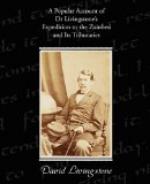Sandia arrived soon after the beast was divided: he is an elderly man, and wears a wig made of “ife” fibre (sanseviera) dyed black, and of a fine glossy appearance. This plant is allied to the aloes, and its thick fleshy leaves, in shape somewhat like our sedges, when bruised yield much fine strong fibre, which is made into ropes, nets, and wigs. It takes dyes readily, and the fibre might form a good article of commerce. “Ife” wigs, as we afterwards saw, are not uncommon in this country, though perhaps not so common as hair wigs at home. Sandia’s mosamela, or small carved wooden pillow, exactly resembling the ancient Egyptian one, was hung from the back of his neck; this pillow and a sleeping mat are usually carried by natives when on hunting excursions.
We had the elephant’s fore-foot cooked for ourselves, in native fashion. A large hole was dug in the ground, in which a fire was made; and, when the inside was thoroughly heated, the entire foot was placed in it, and covered over with the hot ashes and soil; another fire was made above the whole, and kept burning all night. We had the foot thus cooked for breakfast next morning, and found it delicious. It is a whitish mass, slightly gelatinous, and sweet, like marrow. A long march, to prevent biliousness, is a wise precaution after a meal of elephant’s foot. Elephant’s trunk and tongue are also good, and, after long simmering, much resemble the hump of a buffalo and the tongue of an ox; but all the other meat is tough, and, from its peculiar flavour, only to be eaten by a hungry man. The quantities of meat our men devour is quite astounding. They boil as much as their pots will hold, and eat till it becomes physically impossible for them to stow away any more. An uproarious dance follows, accompanied with stentorian song; and as soon as they have shaken their first course down, and washed off the sweat and dust of the after performance, they go to work to roast more: a short snatch of sleep succeeds, and they are up and at it again; all night long it is boil and eat, roast and devour, with a few brief interludes of sleep. Like other carnivora, these men can endure hunger for a much longer period than the mere porridge-eating tribes. Our men can cook meat as well as any reasonable traveller could desire; and, boiled in earthen pots, like Indian chatties, it tastes much better than when cooked in iron ones.
CHAPTER V.
Magnificent scenery—Method of marching—Hippopotamus killed—Lions and buffalo—Sequasha the ivory-trader.




